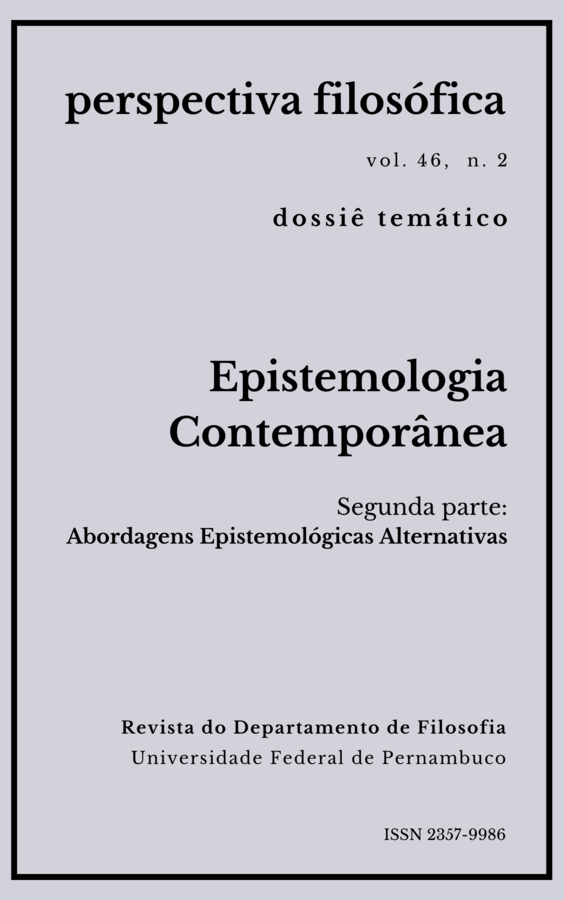Raciocínios analógicos: representacionalismo ou enativismo?
DOI:
https://doi.org/10.51359/2357-9986.2019.248071Keywords:
Analogical reasoning, representationalism, enactivism, modelsAbstract
Analogical reasoning is traditionally conceived as involving comparingmental representations. More recently, with the rise of non-representationa-list theories of human cognition, the question arises of how to explain processes traditionally conceived as representational. In this context, we raisethe discussion of whether mental representations will be part of an explana-tion of analogical reasoning, offering opposite perspectives, with the maingoal of promoting debate. First, we present the view that analogical reaso-ning involves representational mental processes. Next, we present someproblems raised by Fodor for its computational treatment, but we suggestthat these problems do not affect the idea that analogical reasoning involvesmental representations. In the following section, we introduce the linguisticenactivist theory and suggest the possibility that this theory is compatiblewith a conception of analogy as a non-representational categorization pro-cess. Finally, we summarize the two perspectives and suggest that the con-trast of opposite perspectives on cognitive abilities is especially fruitful forour understanding of the mind.References
BARTHA, P. Analogy and analogical reasoning. In: ZALTA, E. (Ed.) TheStanford Encyclopedia of Philosophy. Spring 2019 Edition.<https://plato.stanford.edu/entries/reasoning-analogy>
BUTLIN, P. Representation and the active consumer. Synthese, Ahead ofprint version, 2018. <https://doi.org/10.1007/s11229-018-01941-9>
CARRUTHERS, P. The architecture of the mind: massive modularity andthe flexibility of thought. Oxford: Oxford University Press, 2006.
CARVALHO, E.; ROLLA, G. O desafio da integração explanatória para oenativismo: escalonamento ascendente ou descendente. Revista Prometheus,v. 33, p. 161-181, 2020.
DI PAOLO, E.; CUFFARI, E.; DE JAEGHER, H. Linguistic bodies: thecontinuity between life and language. Cambridge, MA: MIT Press, 2018.
FIGUEIREDO, N. M. Book review: DI PAOLO, Ezequiel, DE JAEGHER,Hanne & CUFFARI, Elena. Linguistic Bodies: The continuity between Lifeand Language. (MIT Press, 2018, 414 pages). Revista Manuscrito, v. 43, n.1, p. 151-170, 2020. <https://doi.org/10.1590/0100-6045.2020.v43n1.nf>
FODOR, J. A. The language of thought. Cambridge, MA: HarvardUniversity Press, 1975.FODOR, J. A. The modularity of mind: an essay on faculty psychology.Cambridge, MA: MIT Press, 1983.
FODOR, J. A. Psychosemantics: the problem of meaning in the philosophy of mind. Cambridge, MA: MIT Press, 1987.
FODOR, J. A. The mind doesn’t work that way: the scope and limits of computational psychology. Cambridge, MA: MIT Press, 2001.
FODOR, J. A. LOT 2: the language of thought revisited. Oxford: Oxford University Press, 2008. <https://doi.org/10.1093/acprof:oso/9780199548774.001.0001>
FORBUS, K. Exploring analogy in the large. In: GENTNER, D.; HOLYOAK, H.; KOKINOV, B. (Eds.) The analogical mind: perspectives from cognitive science. Cambridge MA: The MIT Press, 2001. p. 23-58.
GENTNER, D. Structure-mapping: a theoretical framework for analogy. Cognitive Science, v. 7, n. 2, p. 155-170, 1983. <https://doi.org/10.1207/s15516709cog0702_3>
GENTNER, D.; FORBUS, D. Computational models of analogy. Wiley Interdisciplinary Reviews: Cognitive Science, v. 2, n. 3, 266-276, 2011. <https://doi.org/10.1002/wcs.105>
HOFSTADTER, D. Analogy as the core of cognition. In: GENTNER, D.; HOLYOAK, H.; KOKINOV, B. (Eds.) The analogical mind: perspectives from cognitive science. Cambridge MA: The MIT Press, 2001. p. 499-538.
HOLYOAK, H.; GENTNER, D.; KOKINOV, B. Introduction: the place of analogy in cognition. In: GENTNER, D.; HOLYOAK, H.; KOKINOV, B. (Eds.) The analogical mind: perspectives from cognitive science. Cambridge MA: The MIT Press, 2001. p. 01-19.
HUFFERMANN, J.; NOGUEZ, P. Propostas enativas e a questão da continuidade entre formas de cognição. Revista Prometheus, v. 33, p. 209-229, 2020.
LAKE, B.; ULLMAN, T.; TENENBAUM, J.; GERCHMAN, S. Building machines that learn and think like people. Behavioral and Brain Sciences, v. 40, Artigo E253, 2017. <https://doi.org/10.1017/S0140525X16001837>
ORLANDI, N. The innocent eye: why vision is not a cognitive process. Oxford; New York: Oxford University Press, 2014. <https://doi.org/10.1093/acprof:oso/9780199375035.001.0001>
PINKER, S. So how does the mind work? Mind & Language, v. 20, n. 1, p. 01-24, 2005. <https://doi.org/10.1111/j.0268-1064.2005.00274.x>
RAMSEY, W. Must cognition be representational? Synthese, v. 194, n. 11, p. 4197-4214, 2015. <https://doi.org/10.1007/s11229-014-0644-6>
ROSH, E. Introduction to the revised edition. In: VARELA, F.; THOMPSON, E.; ROSCH, E. The embodied mind: cognitive science and human experience. Revised edition. Cambridge, MA: MIT Press, 2016. p. XXXV-LV.
SCHICKORE, J. Scientific Discovery. ZALTA, E. (Ed.) The Stanford Encyclopedia of Philosophy. Summer 2018 Edition. <https://plato.stanford.edu/entries/scientific-discovery>
SHAW, P. Logic and its limits. Oxford: Oxford University Press, 1997.
THAGARD, P. How scientists explain disease. Princeton: Princeton University Press, 2000.
THAGARD, P.; STEWART, T. The AHA! experience: creativity through emergent binding in neural networks. Cognitive Science, v. 35, n. 1, p. 01-33, 2011. <https://doi.org/10.1111/j.1551-6709.2010.01142.x>
VARELA, F.; THOMPSON, E.; ROSCH, E. The embodied mind: cognitive science and human experience. Revised edition. Cambridge, MA: MIT Press, 2016.
Downloads
Published
Issue
Section
License
A Revista Perspectiva Filosófica orienta seus procedimentos de gestão de artigos conforme as diretrizes básicas formuladas pelo Conselho Nacional de Desenvolvimento Científico e Tecnológico (CNPq). http://www.cnpq.br/web/guest/diretrizesAutores que publicam nesta revista concordam com os seguintes termos:
Os autores mantém os direitos autorais e concedem à revista o direito de primeira publicação, sendo o trabalho simultaneamente licenciado sob https://creativecommons.org/licenses/by/4.0/deed.pt_BR que permite o compartilhamento do trabalho com reconhecimento da autoria e publicação inicial nesta revista.
Os autores têm autorização para assumir contratos adicionais separadamente, para distribuição não-exclusiva da versão do trabalho publicada nesta revista, com reconhecimento de autoria e publicação inicial nesta revista (Consultar http://opcit.eprints.org/oacitation-biblio.html).

Esta revista está licenciada com uma Licença Creative Commons Atribuição 4.0 Internacional.













